
Can Lothians Monitor Farm crack cover crop collaboration?

Livestock and arable farmers can both gain from collaboration but it’s a fine balance to ensure both parties benefit.
That was the key message at the recent Lothians Monitor Farm meeting, where Farm Managers Bill Gray and Peter Eccles are developing a closer collaboration on their neighbouring farms.
Already the two farms share labour during busy periods but they are now exploring sharing land.
Arable farmer Bill has planted up one of Prestonhall’s fields with a stubble turnip cover crop, which Peter will then use to finish some of his lambs. The aim is to improve the structure and organic matter of Bill’s soils for his next arable crop, while Peter gains high energy feed for finishing his larger lamb crop.
Bill explains: “When I look at my field of stubble turnips I think they look great – thick leafy growth which will provide plenty of biomass and increase the organic matter in the soil. But when livestock farmers like Pete look at it they are worried that the bulbs might not grow big enough and so won’t provide as much dry matter for his lambs as he was hoping for.
“It’s a fine balance because I need that biomass but he needs good growth rates. The main thing is we are determined to make it work, so we can show other farmers how they can share resources in a way that can benefit both businesses.”
Peter, who manages next door Saughland Farm, agrees: “This is a huge learning curve, we just need to try things out and then review whether we both got what we needed, whether it was worth the effort for both farms and then work out what, if anything, we need to change. This time next year we will know so much more.”
Local arable and livestock farmers joined in discussions in the turnip field, debating how the lambs should be managed, how to protect their rumen from the transition from grass to turnips, how much dry matter the field should provide and how many lambs could be finished on it, allowing Bill to recoup his establishment costs.
For project manager Gavin Dick, AHDB Cereals & Oilseeds Knowledge Exchange Manager, this type of planned collaboration between local livestock and arable farmers is exactly what he wants to see from the Monitor Farm Scotland programme.
He says: “I’ve worked on Monitor Farms for years and this is the first time I have experienced this type of discussion, with livestock and arable farmers standing in the same field debating how it can be used to benefit a livestock and an arable enterprise.
“We need to be having these types of discussions across farms in Scotland, so we can improve our resource use efficiency across the board, in ways which benefit the bottom line. It can be done, if farmers are willing to engage in debate and try new things.”

